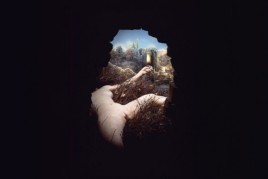Transcript
For the last twenty years of his life, Marcel Duchamp was working secretly in a studio in New York to construct an installation called Étant Donnés, Things Given. In this, the final part of our series, Seeing is Believing: the Politics of the Visual, Rod Stoneman analyses Things Given and he reflects on how Duchamp opened new ways of thinking about art and creativity. The series is presented and produced by Esther Gaytan Fuertes
You will find other podcasts in the series here:
- Podcast 1 on Fashion images
- Podcast 2 on graffiti
- Podcast 3 on music videos
- Podcast 4 on film and climate change
Rod Stoneman: For the last twenty years of his life, Marcel Duchamp was working secretly in a studio in New York to construct an installation called Étant Donnés, or ‘things given’, —one, the waterfall, two, the lighting gas— which no one in the outside world was aware of. These images show the outside door and in that wooden door there are two small peep holes which, if the spectator gets close, you look through into the interior and the image [above] indicates what can be seen.
And the most extraordinary aspects of this major work by certainly one of the twentieth century’s most significant visual artists, was to make something outside of the public domain and only release it after his death. So there was no marketing, there was no gallery, there was no commercial dimension. It was a most significant commitment to an activity but it was done in a way that, very subversively, was outside of the art world, the art market.
A few years before he died he gave a speech called ‘The creative act’. Interestingly before ‘The death of the author’ by Roland Barthes or Foucault’s essay or The Role of the Reader by Umberto Eco, Duchamp talked about the way the meaning of the work of the art is actually made by the spectator.
His Étant Donnés offered the spectator a direct and physical experience of that meaning. Duchamp legislated that it couldn’t be photographed the first 15 years of its existence in the Philadelphia Museum of Art. Obviously this was an epoch —in 1968 when it was constructed in that Museum— it was an epoch before everyone had a camera in their mobile phone. But actually the first photographs of it were only seen in the 80s, when that restriction had been lifted. So the spectator had to see it directly and personally and its implications and its meanings were constrained to that one-to-one relationship.
This actually indicates something of a different way of making art and a much wider and more open and more democratic basis for art-making —leaving aside the commercialised, celebrity basis of commercial art galleries and artists. Duchamp actually suggested that all activity of making, which can be embarked upon by a wide or inclusive range of people actually could be understood as art-making. And it occurs to me that when sometimes people suggest that only professional training and high ability should legitimate creativity that the activity that everyone makes in the middle of the night, which is the highly textured coloured specific strange work of dreaming is actually an indication of the way Duchamp is right. Artistic creativity, imagination, intelligence and meaning are manufactured in a strange brilliant way by all of us on a daily basis. And the definition of what could be seen as a work of art needs to be rethought.
I hope you’ve enjoyed this series. Remember you can listen to the six parts of Seeing is Believing: the Politics of the Visual on Pod Academy’s website, where you can also find our other podcasts and stay up to date with the latest research.
Seeing is Believing: the Politics of the Visual by Rod Stoneman is published by Black Dog (UK £19.95, US £29.95) It explores the complex and reciprocal dynamic between world and image in this most visually mediated society. Everyone ‘knows’ images can be false or deceptive, but we all live and work in constant denial of this idea and its implications. In a world saturatedwith media we act as though we are immune to their effects.Structured in six parts “History/Politics”; “Art/Culture”; “Film/Television”; “Products/Possessions”; “The Quotidian/The Strange”; “Verisimilitude/Delusion”—the book analyses clusters of images to explore differentiated themes of pictorial operation including photography, graffiti, painting, film and television. Seeing is Believing is an invitation to an intimate voyage that is permeable to the world’s upheavals, exploring the potential for contemporary forms of artistic practice to create new spaces for active participation in culture and society.
Tags: Cultural studies, Marcel Duchamp, Media studies, Politics of the visual



Subscribe with…